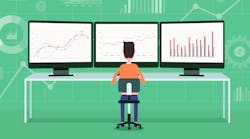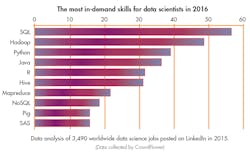Download the PDF of this article.
Automation and robotic systems are replacing many human-operated processes in engineering industries. This trend is happening in places you’d expect (like assembly lines and product manufacturing), but also in more unlikely industries—replacing pharmacists and food service employees, for instance. As we have reported before on Machine Design, with more and more companies investing in robotic systems, the automated services trend shows no sign of slowing down. While many are focused on ways to ensure the future of human jobs in automation—either by introducing collaborative robots, reshoring efforts, or trying to educate and relocate workers in different automation positions—the future of many workers will be in computer programming and data analytics.
The next job wave will not be trying to compete with robots or installing sensors, but learning how to compute and analyze the data they provide.
According to Dan Yarmoluk, an ATEK Access Technologies business development executive for Internet of Things (IoT) products, the future of IoT jobs lie in data analytics and computing. Yarmoluk recently presented “Intelligent Maintenance: Mapping the IIoT Process” at the ATX West Technology Show, which discussed how we need data scientists for tomorrow. In a world that currently has 8.4 billion connected things—up 31% from 2016, and projected to reach 20.4 billion by 2020—“there are currently only 10,000 data scientists in the world,” he noted. The amount of raw data we have coming in from IoT (and all the sensors and smart machines to be deployed) will need to be analyzed and translated into useful information. The untapped potential in this job market is staggering.
The most in demand skills based of 3,490 data science jobs worldwide as found on LinkedIn in 2015. (Image courtesy of CrowdFlower)
According to USA Today, the U.S. Bureau of Labor Statistics has predicted that there will be 1.4 million more software development jobs than applicants by 2020. More than 500,000 jobs in the computing will also become available. However, when you look at the amount of computer science students that graduated last year, it amounts to less than 43,000 according to Code.org. With the potential changes to H-1B visas and infrastructure, including a proposed $1 trillion investment plan, the Trump administration may have a chance to help provide jobs to the unemployed…provided it invests wisely into education and training for the future skilled laborer.
The current national average salary for IT jobs is about $81,000, and is poised to expand by 12% by 2024. There are several opportunities to learn the skills necessary for a job in data science and computing. Bit Source is a code shop founded by mining veteran Rusty Justice to help retrain coal miners as programmers. “Coal miners are really technology workers who get dirty,” he explained.
In Tennessee, CodeTN is a nonprofit organization that encourages high school students to take coding programs at community colleges. Cofounder Caleb Fristoe is trying to combat that the idea that all computer scientists need to be the next Bill Gates or Mark Zuckerberg. “We just need someone to manage the login page,” Fristoe said. “You don’t have to be a superstar.”



